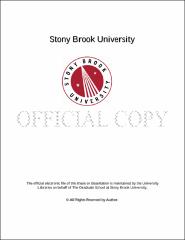| dc.identifier.uri | http://hdl.handle.net/11401/76586 | |
| dc.description.sponsorship | This work is sponsored by the Stony Brook University Graduate School in compliance with the requirements for completion of degree. | en_US |
| dc.format | Monograph | |
| dc.format.medium | Electronic Resource | en_US |
| dc.language.iso | en_US | |
| dc.publisher | The Graduate School, Stony Brook University: Stony Brook, NY. | |
| dc.type | Dissertation | |
| dcterms.abstract | The extracellular matrix (ECM) has emerged as a potential regulator of neural stem cell quiescence and neurogenesis in the adult subventricular zone (SVZ). However, the nature and role of ECM in the developing SVZ has not been determined. During the first postnatal week, radial glia differentiate into ependymal cells and adult neural stem cells, which together organize into adult niche pinwheel structures at the ventricular surface. Using genetic and antibody blocking approaches <italic>in vitro</italic> and <italic>in vivo</italic>, we found that these events coincide with a unique developmental restructuring of ECM in the early postnatal SVZ and that this process is regulated by the ECM receptor dystroglycan. We found that dystroglycan is upregulated in maturing ependymal cells and required for their differentiation and assembly into niche pinwheel structures. Dystroglycan furthermore mediates the association of radial glia with ventricle surface-associated laminins, and genetic deletion of dystroglycan delayed their transition into intermediate gliogenic progenitors and led to abnormal progenitor distribution and proliferation. Dystroglycan loss-of-function also had a dramatic impact on niche output; oligodendrogenesis was increased in dystroglycan-deficient mice and a single injection of dystroglycan blocking antibody into the ventricle of perinatal rats was sufficient to induce oligodendroglial fate in SVZ progenitors. However, the differentiation of dystroglycan-deficient oligodendrocytes was delayed, with the early postnatal corpus callosum containing more oligodendrocyte progenitor cells, and a higher proportion of progenitors with an immature phenotype, resulting in delayed myelination. These findings reveal, for the first time, dystroglycan's role as a master regulator, orchestrating both the assembly and function of the SVZ neural stem cell niche during postnatal gliogenesis. | |
| dcterms.available | 2017-09-20T16:50:42Z | |
| dcterms.contributor | Ge, Shaoyu | en_US |
| dcterms.contributor | Colognato, Holly | en_US |
| dcterms.contributor | Talmage, David | en_US |
| dcterms.contributor | Levine, Joel M | en_US |
| dcterms.contributor | Doetsch, Fiona. | en_US |
| dcterms.creator | McClenahan, Freyja Kirsten | |
| dcterms.dateAccepted | 2017-09-20T16:50:42Z | |
| dcterms.dateSubmitted | 2017-09-20T16:50:42Z | |
| dcterms.description | Department of Neuroscience. | en_US |
| dcterms.extent | 123 pg. | en_US |
| dcterms.format | Application/PDF | en_US |
| dcterms.format | Monograph | |
| dcterms.identifier | http://hdl.handle.net/11401/76586 | |
| dcterms.issued | 2015-08-01 | |
| dcterms.language | en_US | |
| dcterms.provenance | Made available in DSpace on 2017-09-20T16:50:42Z (GMT). No. of bitstreams: 1
McClenahan_grad.sunysb_0771E_11968.pdf: 4569424 bytes, checksum: 802ef2f9096869e426405b0fd88fafef (MD5)
Previous issue date: 2014 | en |
| dcterms.publisher | The Graduate School, Stony Brook University: Stony Brook, NY. | |
| dcterms.subject | Neurosciences | |
| dcterms.subject | extracellular matrix, gliogenesis, laminin, neural stem cell, oligodendrocyte, subventricular zone | |
| dcterms.title | Dystroglycan is a Novel Regulator of Stem Cell Niche Structure and Function in the Developing Postnatal Subventricular Zone | |
| dcterms.type | Dissertation | |

